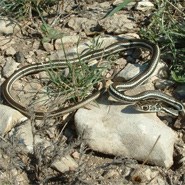
NPS Photo Central Texas Whipsnake Though lizards are its preferred prey, the Central Texas Whipsnake has been known to eat birds, bird eggs, small mammals and even other snakes. It is a proficient climber and can be found in bushes or trees around the reservoir. 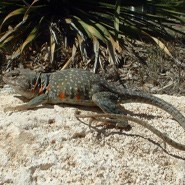
NPS Photo Eastern Collared Lizard Named for the pattern of black bands found around its neck, the Eastern Collared Lizard is characterized by its ability to run on its hind legs at high speeds. These agile lizards can grow up to 30 cm in length. Usually elusive in nature, if escape is not possible they can become very aggressive. 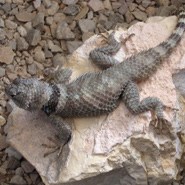
NPS Photo Northern Crevice Spiny Lizard Native to the Chihuahuan Desert, the Northern Crevice Spiny Lizard is named for the texture of its scales. Males of the species bare patches of blue on each side of their belly similar to the markings found on the Texas Spiny Lizard. These shy lizards inhabit arid canyon areas of limestone, rocky outcrops, and large boulders. 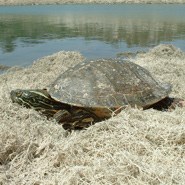
NPS Photo Rio Grande Cooter Also known as the Western River Cooter, the Rio Grande Cooter is commonly found along the Pecos River and Rio Grande drainage systems. These 12 to 16 inch turtles commonly inhabit the non-polluted stretches of the rivers as well as the permanent lakes and ponds in the region. Generally shy, the Rio Grande Cooter will quickly slip into water if approached. 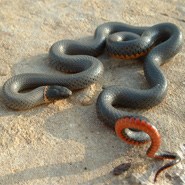
NPS Photo Ring-neck Snake Very secretive snakes, they are usually accidentally discovered by someone overturning their hiding place. The yellow belly may turn red under and near the tail. Known for twisting their tails into tight coils and elevating them, they are nicknamed the “corkscrew” or “thimble” snakes. When held, drops of pungent, clinging saliva may appear at the corner of its mouth. 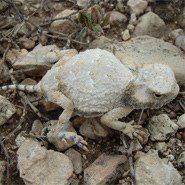
NPS Photo Roundtail Horned Lizard This horned lizard can be distinguished from other lizards of its kind by the absence of a fringe of scales along its sides. A camouflage expert, the Roundtail will flatten itself against the ground when attacked. There, its color so closely resembles the color of the soil, that it is nearly invisible. 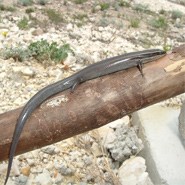
NPS Photo Short-lined Skink 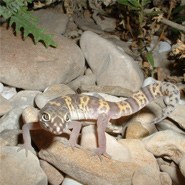
NPS photo Texas Banded Gecko 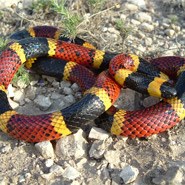
NPS photo Texas Coralsnake 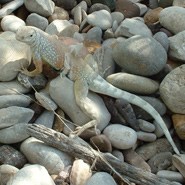
NPS photo Texas Greater Earless Lizard The Texas Greater Earless Lizard is commonly found in areas with broken rocks and limestone cliffs which it uses for shelter. This desert dwelling lizard is extremely active in the heat but may become lethargic on cooler, cloudy days. Its coloration, as well as its speed, help it to blend in with its desert surroundings. 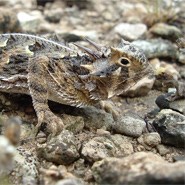
NPS Photo Texas Horned Lizard Also known as the horny toad, this lizard prefers dry, flat terrain with little vegetative cover. Look for them near ant mounds or under rocks and low growing bushes during the late spring and summer when the weather is warmest. Once found throughout the state, the introduction of non-native fire ants, pesticide use, and illegal collecting have seriously threatened remaining populations. 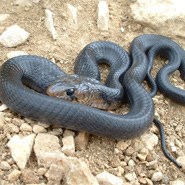
NPS Photo Texas Indigo Snake 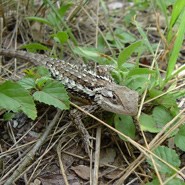
NPS Photo Texas Spiny Lizard The Texas Spiny Lizard (found in the mesquite trees of North-Central, Central, and Southern Texas) can grow to length’s of 7 ½ to 11 inches. Texas Spiny Lizards utilize their long toes and sharp toenails to skillfully climb the trees in which they live. Their brownish color helps them blend into the bark on which they live. Coloration may vary slightly for each lizard. Males, however, can be distinguished from females by blue markings on each side of the belly. 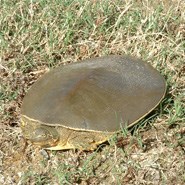
NPS Photo Texas Spiny Softshell Look for this turtle basking along the edges of the reservoir in muddy areas with a moving current. The Texas Spiny Softshell is a fast swimmer and can be very aggressive, which makes it difficult to observe or handle. 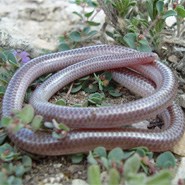
NPS Photo Texas Threadsnake 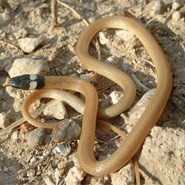
NPS photo Trans-Pecos Blackheaded Snake 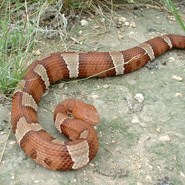
NPS Photo Trans-Pecos Copperhead This subspecies is the western most ranging copperhead, living in isolated populations in desert oases. Generally occurring near wet canyons and permanent springs, they can occasionally be found in the desert during the rainy season. 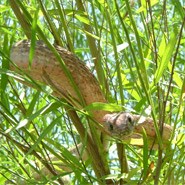
NPS Photo Western Coachwhip This snake is among the longest snakes in Texas and is also one of the most active. Unlike many other serpents, the Western Coachwhip will venture out during the day, even in the summer heat. Generally, this snake is found under low bushes in areas with sandy or rocky terrain. Also called ‘Red Racer,’ this snake has the unfortunate habit of trying to cross highways, where it is often killed. 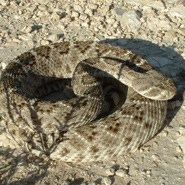
NPS photo Western Diamondback Rattlesnake Along with its cousin, the Eastern Diamondback, it is ranked as one of the world’s largest and most dangerous snakes. In North America it is responsible for more serious bites and fatalities than any other serpent. When harassed, it may raise its head high above its coiled body to gain better aim for striking. They can be found in lowlands, altitudes up to 5,000 ft, or in rocky canyons and cliffs. 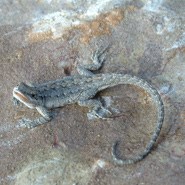
NPS Photo Big Bend Tree Lizard Though similar in appearance to the eastern tree lizard, the Big Bend tree Lizard is found only in the Big Bend and Trans-Pecos regions of Texas and along the border of Mexico and New Mexico. Most often found resting vertically on trees and rock faces, these small lizards startle easily and can be difficult to spot. |
Last updated: July 9, 2016
